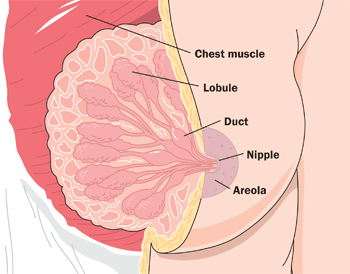
Inside the breast

The breast and nearby lymph nodes
Image courtesy of the National Cancer Institute
What is breast cancer?
Breast basics
A woman’s breast is made of glandular tissue, connective tissue, fatty tissue, blood vessels, lymph tissue, and nerves. Each breast contains up to 20 sections of glandular tissue called lobes. Each lobe has many smaller sections called lobules, where milk is made. Milk flows from the lobules through thin tubes called ducts to the nipple. The nipple is the small, raised area at the tip of the breast. The areola is the area of darker-colored skin around the nipple.
Each breast also contains lymph vessels. These are thin tubes that carry lymph to small, bean-shaped glands called lymph nodes. Lymph nodes are found near the breast, under the arm, and throughout the body. Lymph nodes and lymph vessels are part of the lymph system, which helps your body fight disease and infection. The chest muscle and chest wall are behind the breasts.
Breast cancer
Cancer is a disease in which cells become abnormal and form more cells in an uncontrolled way. With breast cancer, the cancer begins in the tissues that make up the breasts. The cancer cells may form a mass called a tumor. (Note: Not all tumors are cancer.) They may also invade nearby tissue and spread to lymph nodes and other parts of the body. The most common types of breast cancer are:
- Ductal carcinoma – Cancer that begins in the ducts and grows into surrounding tissues. About 8 in 10 breast cancers are this type.
- Lobular carcinoma (LAH-byuh-luhr KAR-sih-NOH-muh) – Cancer that begins in lobules and grows into surrounding tissues. About 1 in 10 breast cancers are this type.
With routine screening, breast cancer often can be found at an early stage, before the cancer has spread.
More information on breast cancer
Read more from womenshealth.gov
-
Breast Cancer Fact Sheet — This fact sheet provides information on why women should be concerned about breast cancer and gives resources for more information.
http://www.womenshealth.gov/publications/our-publications/fact-sheet/breast-cancer.cfm
-
Early-stage Breast Cancer Treatment Fact Sheet — This fact sheet addresses questions that women commonly have about breast cancer and its treatment. It explains the two surgical options used to treat early-stage breast cancer and lists resources for patients seeking more information.
http://www.womenshealth.gov/publications/our-publications/fact-sheet/early-stage-breast-cancer.cfm
-
Mammograms Fact Sheet — This fact sheet discusses the different types of mammograms available, explains how often a woman should get them, and gives facts about their safety and effectiveness.
http://www.womenshealth.gov/publications/our-publications/fact-sheet/mammograms.cfm
Explore other publications and websites
-
Breast Cancer — This publication provides general information about breast cancer, including risk factors, screening methods, diagnosis, staging, and treatment. It also gives information on recent breast cancer research.
http://nihseniorhealth.gov/breastcancer/toc.html
-
Understanding Breast Changes: A Health Guide for Women — This booklet explains normal, age-related breast changes you may experience throughout your life and how they differ from changes that indicate breast cancer. It also discusses mammograms and maintaining your breast health.
http://www.cancer.gov/cancertopics/screening/understanding-breast-changes/allpages
Connect with other organizations
-
American Cancer Society
http://www.cancer.org/docroot/home/index.asp
-
Breast Cancer Action
http://www.bcaction.org/
-
Division of Cancer Prevention and Control, NCCDPHP, CDC
http://www.cdc.gov/cancer/
-
National Breast and Cervical Cancer Early Detection Program, CDC
http://www.cdc.gov/cancer/nbccedp/
-
National Cancer Institute, NIH
http://www.cancer.gov/
-
Sister Study, NIEHS, NIH, HHS
http://www.sisterstudy.org/English/index1.htm
-
Susan G. Komen for the Cure
http://ww5.komen.org/
-
Y-Me National Breast Cancer Organization
http://www.y-me.org/
Content last updated November 17, 2010.
Resources last updated November 17, 2010.
womenshealth.gov
A federal government website managed by the Office on Women's Health in the Office of the Assistant Secretary for Health at the U.S. Department of Health and Human Services.
200 Independence Avenue, S.W. • Washington, DC 20201


 Text size
Text size Email
Email
